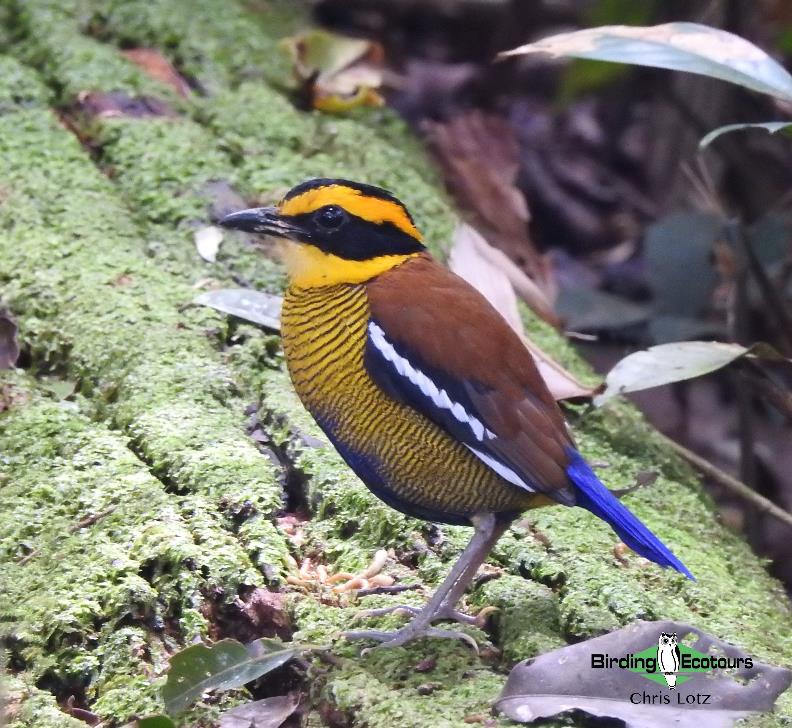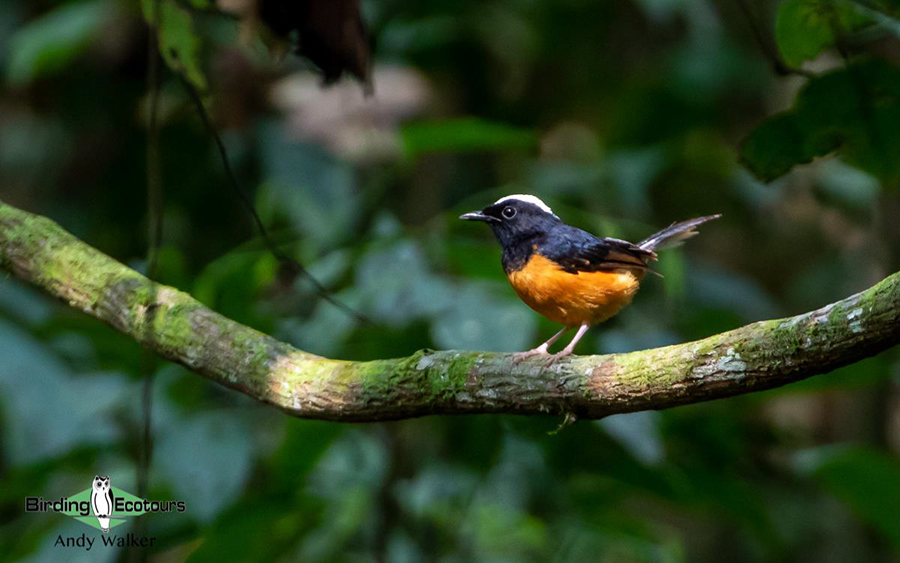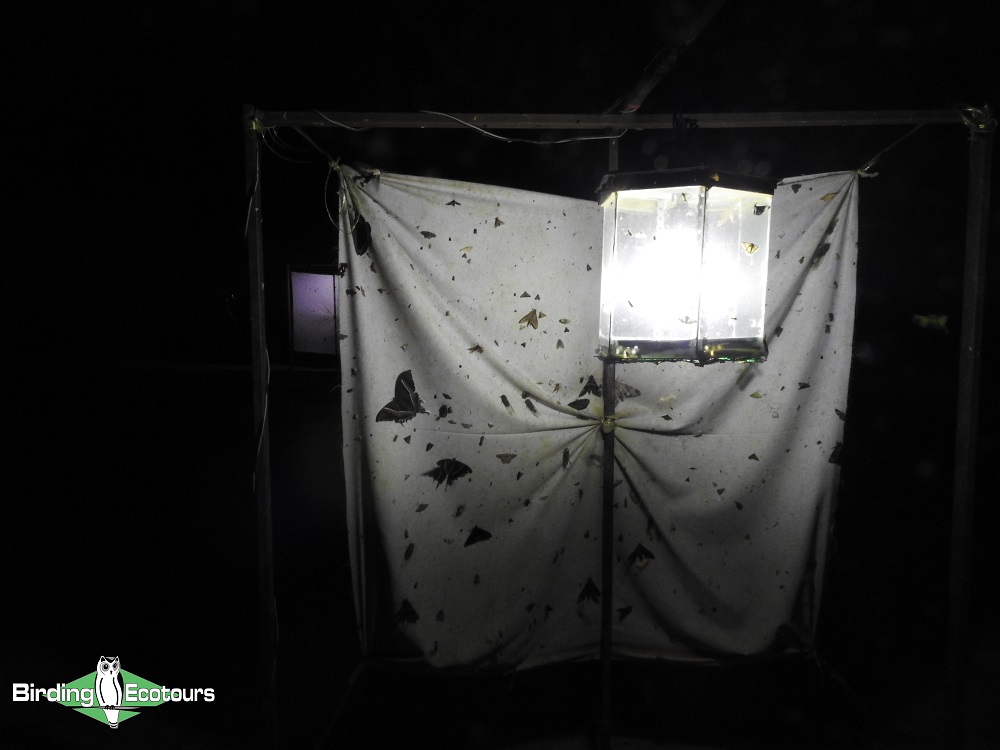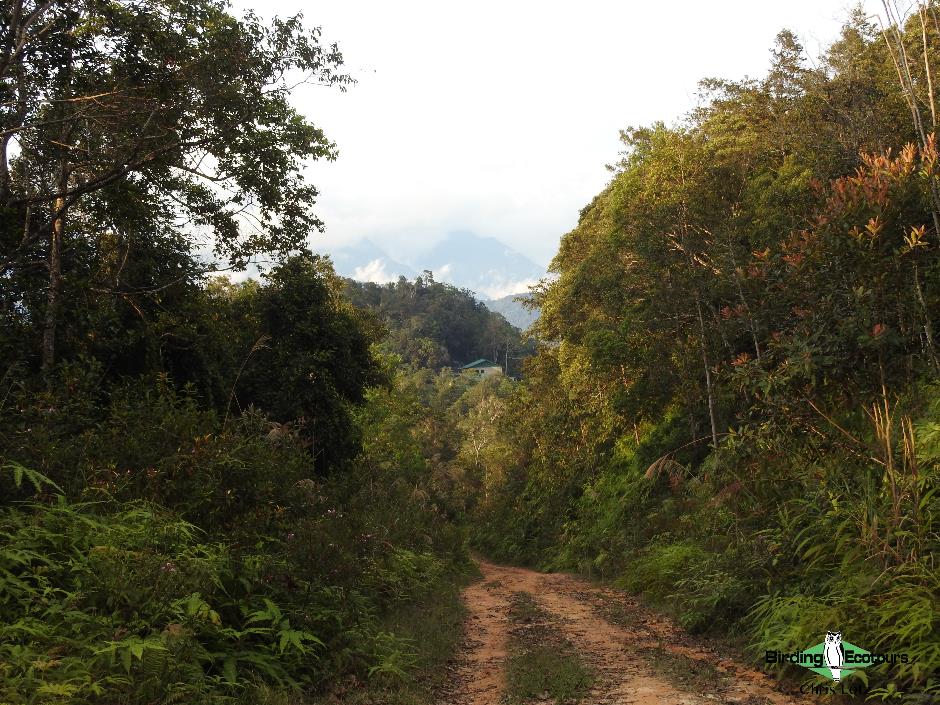Go to Borneo Premium bird tour page | Borneo bird tours | Asian trip reports | All our birding tours
27 – 29 September 2022
By Chris Lotz
 Bornean Banded Pitta on a log just outside the Bulwer’s Pheasant blind (hide).
Bornean Banded Pitta on a log just outside the Bulwer’s Pheasant blind (hide).
Overview
What a trip this proved to be! It met all the expectations of our short Bulwer’s Pheasant blog here. Mount Trusmadi is Malaysia’s second highest peak (after Mount Kinabalu) at about 8,000 feet (2,642 meters) and on this birding tour we focused our efforts on the forested Trusmadi highlands, with the peak visible in the distance.
The trip was really successful, not only did we obtain multiple close-up views of three Bulwer’s Pheasants (a pair and a single male), one of the most enigmatic birds in Asia, but we also saw close-up Crested Partridges (Roul-rouls) and Great Argus too, along with splendid views of Bornean Banded Pitta and the more elusive, Blue-banded Pitta. There were plenty of other star Bornean endemic birds seen too, like White-crowned Shama, Dayak Blue Flycatcher, and Bornean Leafbird. Mammals were also good, with several species seen in a very short time. We plan to add this trip to our set departure tour repertoire so watch this space for details. We may also include Bornean Peacock-Pheasant which is currently (2022) showing quite reliably in a different part of Sabah. Combine this with our Sarawak restricted range bird species tour and our classic Sabah birding tour and you’ll be able to see the bulk of Malaysian Borneo’s star birds.

Detailed Report
Day 1, 27th September 2022. Kota Kinabalu to Trusmadi highlands
We departed from Kota Kinabalu at 6 am, stopping for an excellent breakfast midway between there and our accommodation near Mount Trusmadi. By late morning we had already checked in and were able to enjoy a tasty lunch before trying for the elusive Blue-banded Pitta, which we did get extremely close to (judging from its call), but without visuals (for now…). We then drove to the pheasant blind (hide) and were richly rewarded with our main target, Bulwer’s Pheasant (three of them, a pair and a single male) along with a female Great Argus that also showed well. What an amazing start to this short tour, one of Asia’s most highly anticipated species was in the bag already! White-crowned Shama also put in an appearance, as did numerous entertaining, very active, Low’s Squirrels. A short walk near the hide after a fantastic three hours in it, to try and see a calling Sunda Cuckoo (sadly without success on visuals), did generate Slender Squirrel.
Bulwer’s Pheasant!
In the evening, we saw a Malay Civet around the lodgings, along with a huge Long-horned Beetle. We then walked the short distance to the legendary moth traps and saw not only a host of incredible moths and other insects, but also a magnificent Barred Eagle-Owl nearby.

Day 2, 28th September 2022. Full day birding in the Trusmadi highlands
Today was an epic day. We started at the blind again and saw the Bulwer’s Pheasant pair nicely. Great Argus was less co-operative, and we only heard a couple of them close-by, failing to lay eyes on them. A beautiful Black-and-red Broadbill showed briefly, while Temminck’s Babbler and Dayak Blue Flycatcher gave more prolonged views. A close-up Yellow-throated Marten was a true highlight and a Southern Red Muntjac showed itself a couple of times. After breakfast in the blind, we tried for Blue-banded Pitta again, but we only heard it (as is commonly the case; one should never underestimate the elusiveness of this species).
After lunch, we headed for a different blind which was also extremely productive. At least a dozen Crested Partridges arrived and gave us excellent views – both males and female birds. A close-up Bornean Banded Pitta gave ridiculously close views as it sat on top of a log just outside the blind (see trip report cover image). What a beauty! Mammals were (as usual for Borneo) great at this hide, and included a Mountain Treeshrew, Horse-tailed Squirrel, and Slender Squirrel.
Roadside birding between sessions at the blind always proved good, and we encountered the attractive Crimson-winged Woodpecker, Asian Brown Flycatcher, Scaly-breasted Bulbul, Streaked Bulbul, various other more common bulbul species, Velvet-fronted Nuthatch, Bornean Leafbird, Grey-rumped Treeswift (awesome to see through the scope sitting in a dead tree), dazzling Temminck’s Sunbird and the drabber Purple-naped Sunbird, Black-sided Flowerpecker, Little Spiderhunter, Orange-bellied Flowerpecker, and Plain Flowerpecker.

Day 3, 29th September 2022. Trusmadi highlands to Kota Kinabalu
We spent an early morning session in the hide again where the pair of Bulwer’s Pheasants showed magnificently again, but the male Great Argus still did not show despite calling nearby and a brief appearance by the female. We then went to look for Blue-banded Pitta and were richly rewarded with great views high in a tree after some patient waiting. We also enjoyed some roadside birding, which gave great views of Little Cuckoo-Dove and some poorer views of Bushy-crested Hornbill and White-crowned Hornbill. We then transferred back to Kota Kinabalu, getting great views of White-fronted (Bornean) Falconet en route. We saw the falconet catch a large insect and consume it.
All in all, this was a superb trip, with pleasant temperatures in the highlands, a nice place to stay for two nights, and star birds and other wildlife, not to mention great company.
Bird List – Following IOC (12.1)
Birds ‘heard only’ are marked with (H) after the common name, all other species were seen. The following notation after species names is used to show conservation status following BirdLife International: VU = Vulnerable. The common name for Bornean endemics is shown in bold type, e.g., Bulwer’s Pheasant.
| Common Name | Scientific Name |
| Pheasants & Allies (Phasianidae) | |
| Red-breasted Partridge (H) | Arborophila hyperythra |
| Crested Partridge | Rollulus rouloul |
| Bulwer’s Pheasant – VU | Lophura bulweri |
| Great Argus | Argusianus argus |
| Herons, Bitterns (Ardeidae) | |
| Great Egret | Ardea alba |
| Little Egret | Egretta garzetta |
| Rails, Crakes & Coots (Rallidae) | |
| White-breasted Waterhen | Amaurornis phoenicurus |
| Sandpipers, Snipes (Scolopacidae) | |
| Common Sandpiper | Actitis hypoleucos |
| Pigeons, Doves (Columbidae) | |
| Spotted Dove | Spilopelia chinensis |
| Little Cuckoo-Dove | Macropygia ruficeps |
| Zebra Dove | Geopelia striata |
| Cuckoos (Cuculidae) | |
| Greater Coucal | Centropus sinensis |
| Sunda Cuckoo (H) | Cuculus lepidus |
| Owls (Strigidae) | |
| Barred Eagle-Owl | Bubo sumatranus |
| Treeswifts (Hemiprocnidae) | |
| Grey-rumped Treeswift | Hemiprocne longipennis |
| Swifts (Apodidae) | |
| Plume-toed Swiftlet | Collocalia affinis |
| Bee-eaters (Meropidae) | |
| Red-bearded Bee-eater | Nyctyornis amictus |
| Hornbills (Bucerotidae) | |
| White-crowned Hornbill | Berenicornis comatus |
| Bushy-crested Hornbill | Anorrhinus galeritus |
| Woodpeckers (Picidae) | |
| Crimson-winged Woodpecker | Picus puniceus |
| Caracaras, Falcons (Falconidae) | |
| White-fronted Falconet | Microhierax latifrons |
| Pittas (Pittidae) | |
| Bornean Banded Pitta | Hydrornis schwaneri |
| Blue-banded Pitta | Erythropitta arquata |
| Cuckooshrikes (Campephagidae) | |
| Scarlet Minivet | Pericrocotus speciosus |
| Drongos (Dicruridae) | |
| Ashy Drongo | Dicrurus leucophaeus |
| Crows, Jays (Corvidae) | |
| Bornean Treepie (H) | Dendrocitta cinerascens |
| Rail-babbler (Eupetidae) | |
| Rail-babbler (H) | Eupetes macrocerus |
| Bulbuls (Pycnonotidae) | |
| Scaly-breasted Bulbul | Pycnonotus squamatus |
| Yellow-vented Bulbul | Pycnonotus goiavier |
| Asian Red-eyed Bulbul | Pycnonotus brunneus |
| Charlotte’s Bulbul | Iole charlottae |
| Streaked Bulbul | Ixos malaccensis |
| Cinereous Bulbul | Hemixos cinereus |
| Swallows, Martins (Hirundinidae) | |
| Barn Swallow | Hirundo rustica |
| Pacific Swallow | Hirundo tahitica |
| Cisticolas & Allies (Cisticolidae) | |
| Yellow-bellied Prinia | Prinia flaviventris |
| Ashy Tailorbird | Orthotomus ruficeps |
| Babblers (Timaliidae) | |
| Bold-striped Tit-Babbler | Macronus bornensis |
| Fulvettas, Ground Babblers (Pellorneidae) | |
| Temminck’s Babbler | Pellorneum pyrrogenys |
| White-eyes (Zosteropidae) | |
| Pygmy White-eye | Oculocincta squamifrons |
| Nuthatches (Sittidae) | |
| Velvet-fronted Nuthatch | Sitta frontalis |
| Chats, Old World Flycatchers (Muscicapidae) | |
| White-crowned Shama | Copsychus stricklandii |
| Asian Brown Flycatcher | Muscicapa dauurica |
| Dayak Blue Flycatcher | Cyornis montanus |
| Indigo Flycatcher | Eumyias indigo |
| Leafbirds (Chloropseidae) | |
| Bornean Leafbird | Chloropsis kinabaluensis |
| Flowerpeckers (Dicaeidae) | |
| Yellow-rumped Flowerpecker | Prionochilus xanthopygius |
| Orange-bellied Flowerpecker | Dicaeum trigonostigma |
| Black-sided Flowerpecker | Dicaeum monticolum |
| Sunbirds (Nectariniidae) | |
| Plain Sunbird | Anthreptes simplex |
| Temminck’s Sunbird | Aethopyga temminckii |
| Purple-naped Sunbird | Hypogramma hypogrammicum |
| Little Spiderhunter | Arachnothera longirostra |
| Wagtails, Pipits (Motacillidae) | |
| Grey Wagtail | Motacilla cinerea |
| Total seen | 50 |
| Total heard only | 4 |
| Total recorded | 54 |
Mammal List
| Common Name | Scientific Name |
| Squirrels (Sciuridae) | |
| Horse-tailed Squirrel | Sundasciurus hippurus |
| Low’s Squirrel | Sundasciurus lowii |
| Slender Squirrel | Sundasciurus tenuis |
| Treeshrews (Tupaiidae) | |
| Mountain Treeshrew | Tupia montana |
| Old World Monkeys (Cercopithecidae) | |
| Southern Pig-tailed Macaque | Macaca nemestrina |
| Civets, Genets, & Oyans (Viverridae) | |
| Malay (Palm) Civet | Viverra tangalunga |
| Mustelids (Mustelidae) | |
| Yellow-throated Marten | Martes flavigula |
| Deer (Cervidae) | |
| Southern Red Muntjac | Muntiacus muntjak |
| Total | 8 |